Construction Project Procurement and Risk Management
VerifiedAdded on 2023/06/03
|11
|2164
|228
AI Summary
This article discusses procurement and risk management in construction projects. It covers topics such as design-build project delivery, subcontractor selection, safety and risk auditing, and EMV estimation. The article also explores strategies for sustainable procurement and provides a bow-tie analysis report for a typical risk event in a refurbishment project.
Contribute Materials
Your contribution can guide someone’s learning journey. Share your
documents today.
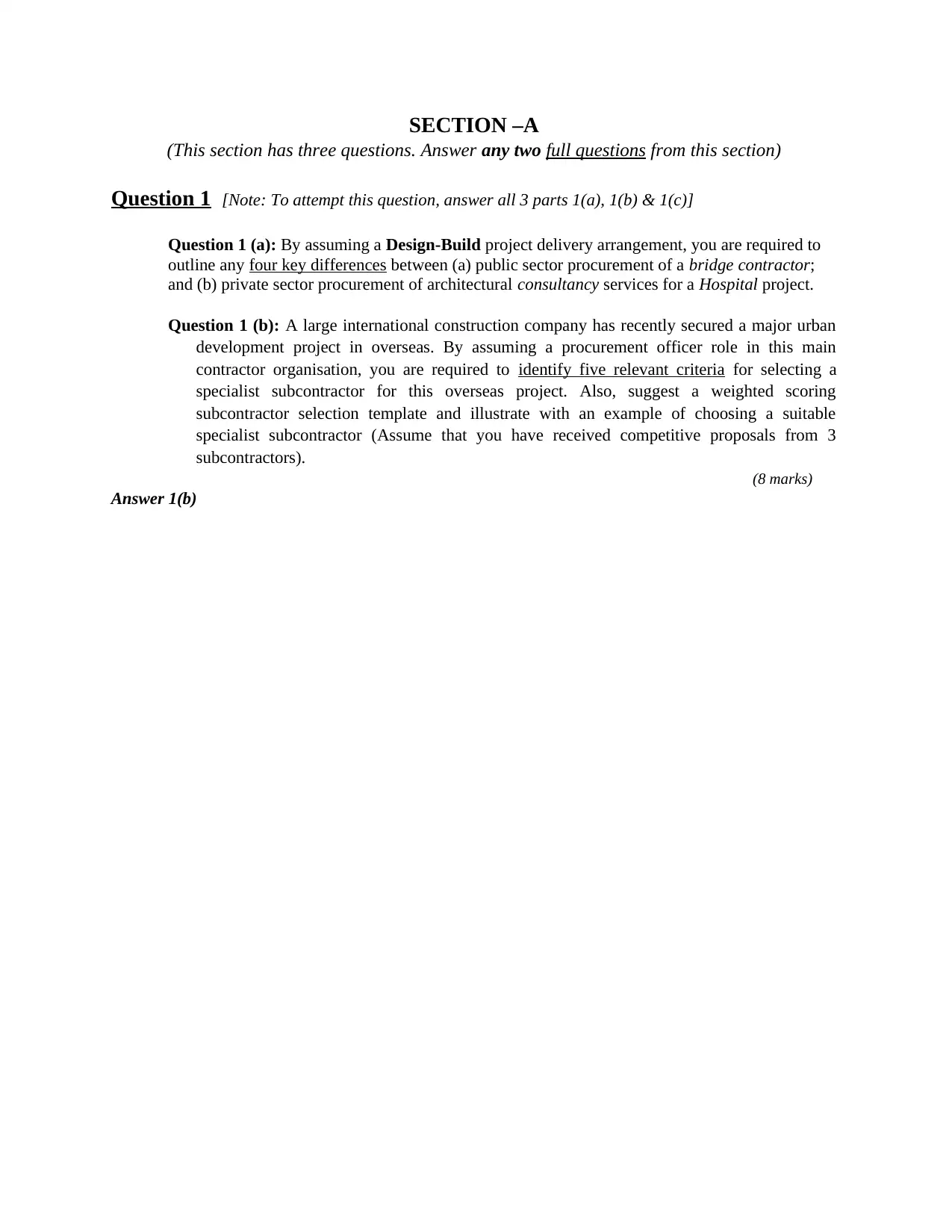
SECTION –A
(This section has three questions. Answer any two full questions from this section)
Question 1 [Note: To attempt this question, answer all 3 parts 1(a), 1(b) & 1(c)]
Question 1 (a): By assuming a Design-Build project delivery arrangement, you are required to
outline any four key differences between (a) public sector procurement of a bridge contractor;
and (b) private sector procurement of architectural consultancy services for a Hospital project.
Question 1 (b): A large international construction company has recently secured a major urban
development project in overseas. By assuming a procurement officer role in this main
contractor organisation, you are required to identify five relevant criteria for selecting a
specialist subcontractor for this overseas project. Also, suggest a weighted scoring
subcontractor selection template and illustrate with an example of choosing a suitable
specialist subcontractor (Assume that you have received competitive proposals from 3
subcontractors).
(8 marks)
Answer 1(b)
(This section has three questions. Answer any two full questions from this section)
Question 1 [Note: To attempt this question, answer all 3 parts 1(a), 1(b) & 1(c)]
Question 1 (a): By assuming a Design-Build project delivery arrangement, you are required to
outline any four key differences between (a) public sector procurement of a bridge contractor;
and (b) private sector procurement of architectural consultancy services for a Hospital project.
Question 1 (b): A large international construction company has recently secured a major urban
development project in overseas. By assuming a procurement officer role in this main
contractor organisation, you are required to identify five relevant criteria for selecting a
specialist subcontractor for this overseas project. Also, suggest a weighted scoring
subcontractor selection template and illustrate with an example of choosing a suitable
specialist subcontractor (Assume that you have received competitive proposals from 3
subcontractors).
(8 marks)
Answer 1(b)
Secure Best Marks with AI Grader
Need help grading? Try our AI Grader for instant feedback on your assignments.
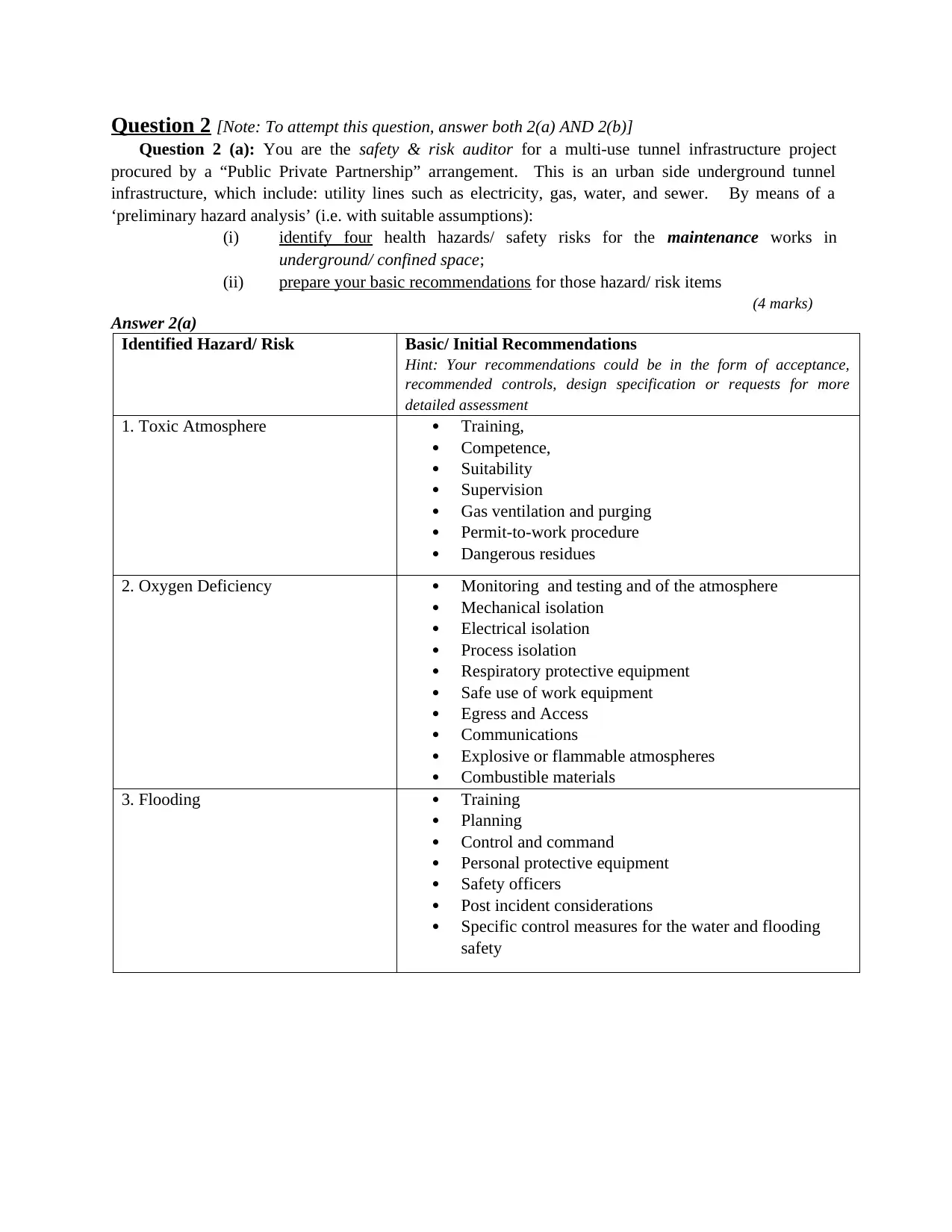
Question 2 [Note: To attempt this question, answer both 2(a) AND 2(b)]
Question 2 (a): You are the safety & risk auditor for a multi-use tunnel infrastructure project
procured by a “Public Private Partnership” arrangement. This is an urban side underground tunnel
infrastructure, which include: utility lines such as electricity, gas, water, and sewer. By means of a
‘preliminary hazard analysis’ (i.e. with suitable assumptions):
(i) identify four health hazards/ safety risks for the maintenance works in
underground/ confined space;
(ii) prepare your basic recommendations for those hazard/ risk items
(4 marks)
Answer 2(a)
Identified Hazard/ Risk Basic/ Initial Recommendations
Hint: Your recommendations could be in the form of acceptance,
recommended controls, design specification or requests for more
detailed assessment
1. Toxic Atmosphere Training,
Competence,
Suitability
Supervision
Gas ventilation and purging
Permit-to-work procedure
Dangerous residues
2. Oxygen Deficiency Monitoring and testing and of the atmosphere
Mechanical isolation
Electrical isolation
Process isolation
Respiratory protective equipment
Safe use of work equipment
Egress and Access
Communications
Explosive or flammable atmospheres
Combustible materials
3. Flooding Training
Planning
Control and command
Personal protective equipment
Safety officers
Post incident considerations
Specific control measures for the water and flooding
safety
Question 2 (a): You are the safety & risk auditor for a multi-use tunnel infrastructure project
procured by a “Public Private Partnership” arrangement. This is an urban side underground tunnel
infrastructure, which include: utility lines such as electricity, gas, water, and sewer. By means of a
‘preliminary hazard analysis’ (i.e. with suitable assumptions):
(i) identify four health hazards/ safety risks for the maintenance works in
underground/ confined space;
(ii) prepare your basic recommendations for those hazard/ risk items
(4 marks)
Answer 2(a)
Identified Hazard/ Risk Basic/ Initial Recommendations
Hint: Your recommendations could be in the form of acceptance,
recommended controls, design specification or requests for more
detailed assessment
1. Toxic Atmosphere Training,
Competence,
Suitability
Supervision
Gas ventilation and purging
Permit-to-work procedure
Dangerous residues
2. Oxygen Deficiency Monitoring and testing and of the atmosphere
Mechanical isolation
Electrical isolation
Process isolation
Respiratory protective equipment
Safe use of work equipment
Egress and Access
Communications
Explosive or flammable atmospheres
Combustible materials
3. Flooding Training
Planning
Control and command
Personal protective equipment
Safety officers
Post incident considerations
Specific control measures for the water and flooding
safety
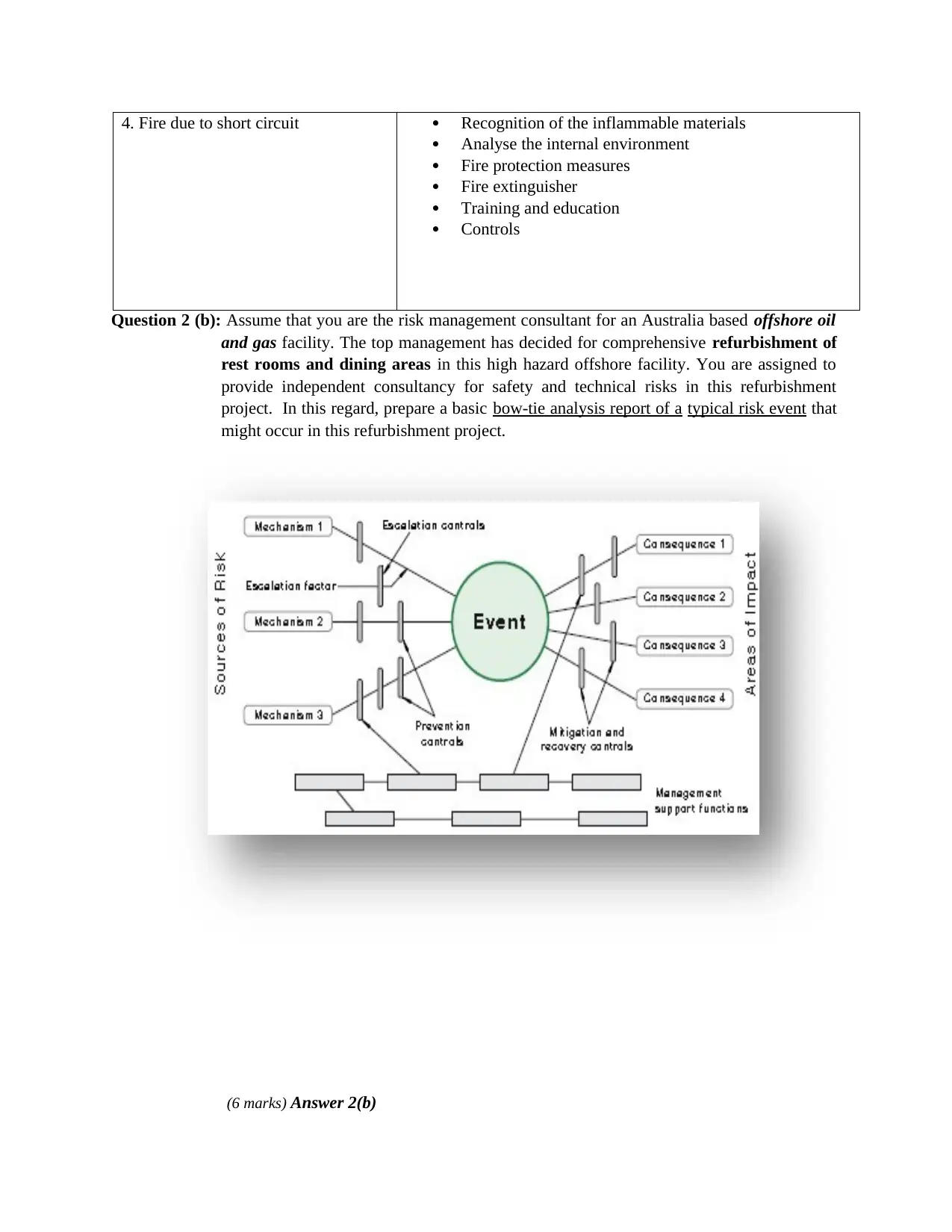
4. Fire due to short circuit Recognition of the inflammable materials
Analyse the internal environment
Fire protection measures
Fire extinguisher
Training and education
Controls
Question 2 (b): Assume that you are the risk management consultant for an Australia based offshore oil
and gas facility. The top management has decided for comprehensive refurbishment of
rest rooms and dining areas in this high hazard offshore facility. You are assigned to
provide independent consultancy for safety and technical risks in this refurbishment
project. In this regard, prepare a basic bow-tie analysis report of a typical risk event that
might occur in this refurbishment project.
(6 marks) Answer 2(b)
Analyse the internal environment
Fire protection measures
Fire extinguisher
Training and education
Controls
Question 2 (b): Assume that you are the risk management consultant for an Australia based offshore oil
and gas facility. The top management has decided for comprehensive refurbishment of
rest rooms and dining areas in this high hazard offshore facility. You are assigned to
provide independent consultancy for safety and technical risks in this refurbishment
project. In this regard, prepare a basic bow-tie analysis report of a typical risk event that
might occur in this refurbishment project.
(6 marks) Answer 2(b)
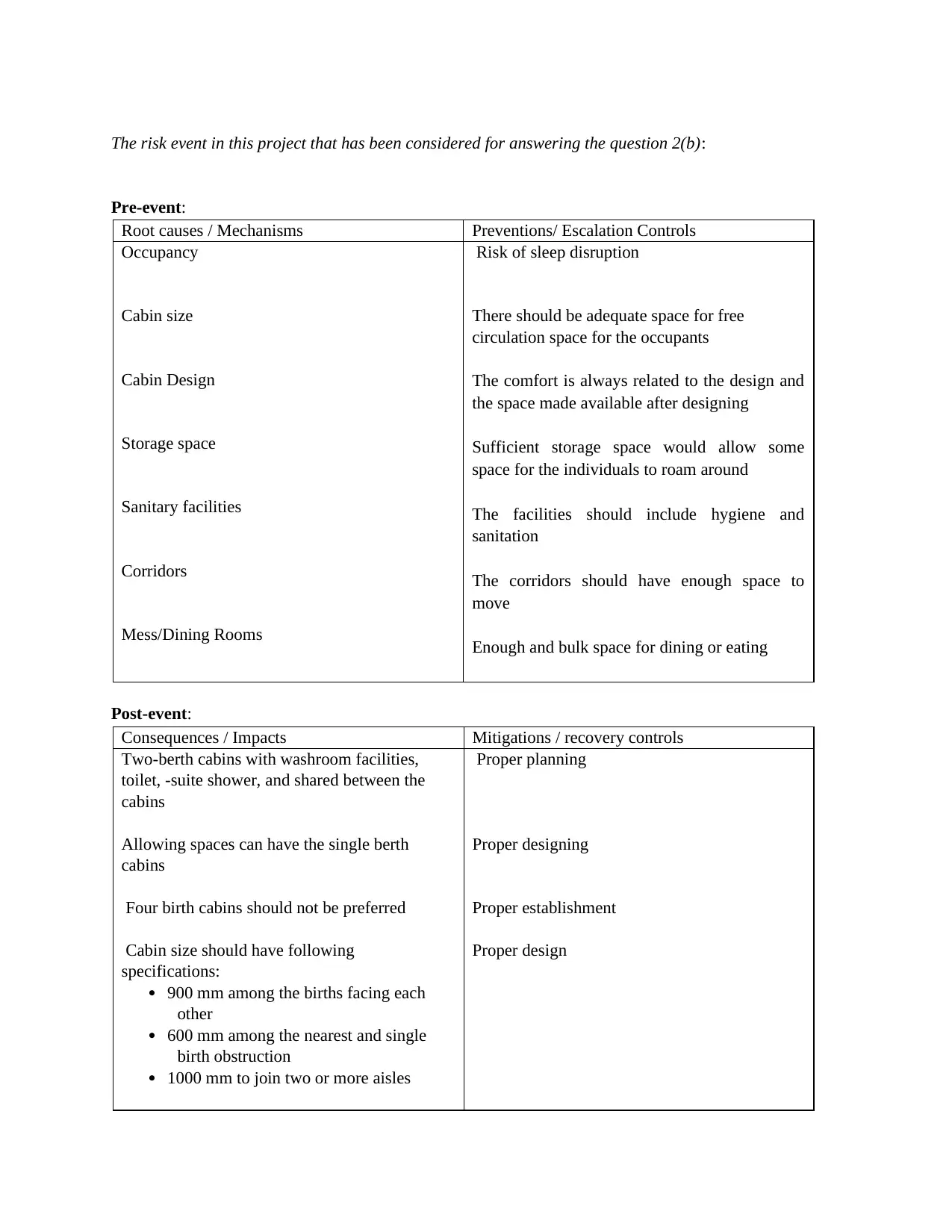
The risk event in this project that has been considered for answering the question 2(b):
Pre-event:
Root causes / Mechanisms Preventions/ Escalation Controls
Occupancy
Cabin size
Cabin Design
Storage space
Sanitary facilities
Corridors
Mess/Dining Rooms
Risk of sleep disruption
There should be adequate space for free
circulation space for the occupants
The comfort is always related to the design and
the space made available after designing
Sufficient storage space would allow some
space for the individuals to roam around
The facilities should include hygiene and
sanitation
The corridors should have enough space to
move
Enough and bulk space for dining or eating
Post-event:
Consequences / Impacts Mitigations / recovery controls
Two-berth cabins with washroom facilities,
toilet, -suite shower, and shared between the
cabins
Allowing spaces can have the single berth
cabins
Four birth cabins should not be preferred
Cabin size should have following
specifications:
900 mm among the births facing each
other
600 mm among the nearest and single
birth obstruction
1000 mm to join two or more aisles
Proper planning
Proper designing
Proper establishment
Proper design
Pre-event:
Root causes / Mechanisms Preventions/ Escalation Controls
Occupancy
Cabin size
Cabin Design
Storage space
Sanitary facilities
Corridors
Mess/Dining Rooms
Risk of sleep disruption
There should be adequate space for free
circulation space for the occupants
The comfort is always related to the design and
the space made available after designing
Sufficient storage space would allow some
space for the individuals to roam around
The facilities should include hygiene and
sanitation
The corridors should have enough space to
move
Enough and bulk space for dining or eating
Post-event:
Consequences / Impacts Mitigations / recovery controls
Two-berth cabins with washroom facilities,
toilet, -suite shower, and shared between the
cabins
Allowing spaces can have the single berth
cabins
Four birth cabins should not be preferred
Cabin size should have following
specifications:
900 mm among the births facing each
other
600 mm among the nearest and single
birth obstruction
1000 mm to join two or more aisles
Proper planning
Proper designing
Proper establishment
Proper design
Secure Best Marks with AI Grader
Need help grading? Try our AI Grader for instant feedback on your assignments.
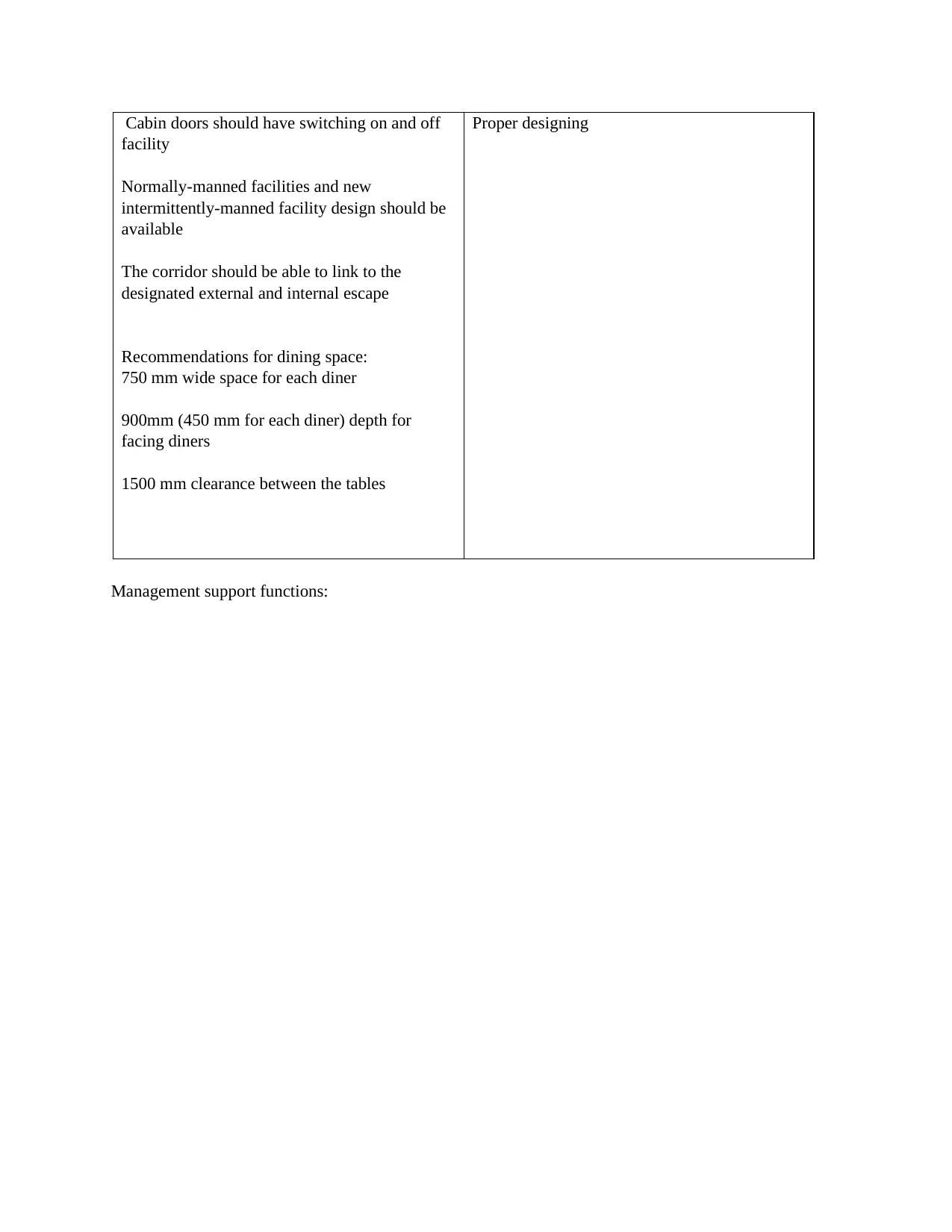
Cabin doors should have switching on and off
facility
Normally-manned facilities and new
intermittently-manned facility design should be
available
The corridor should be able to link to the
designated external and internal escape
Recommendations for dining space:
750 mm wide space for each diner
900mm (450 mm for each diner) depth for
facing diners
1500 mm clearance between the tables
Proper designing
Management support functions:
facility
Normally-manned facilities and new
intermittently-manned facility design should be
available
The corridor should be able to link to the
designated external and internal escape
Recommendations for dining space:
750 mm wide space for each diner
900mm (450 mm for each diner) depth for
facing diners
1500 mm clearance between the tables
Proper designing
Management support functions:
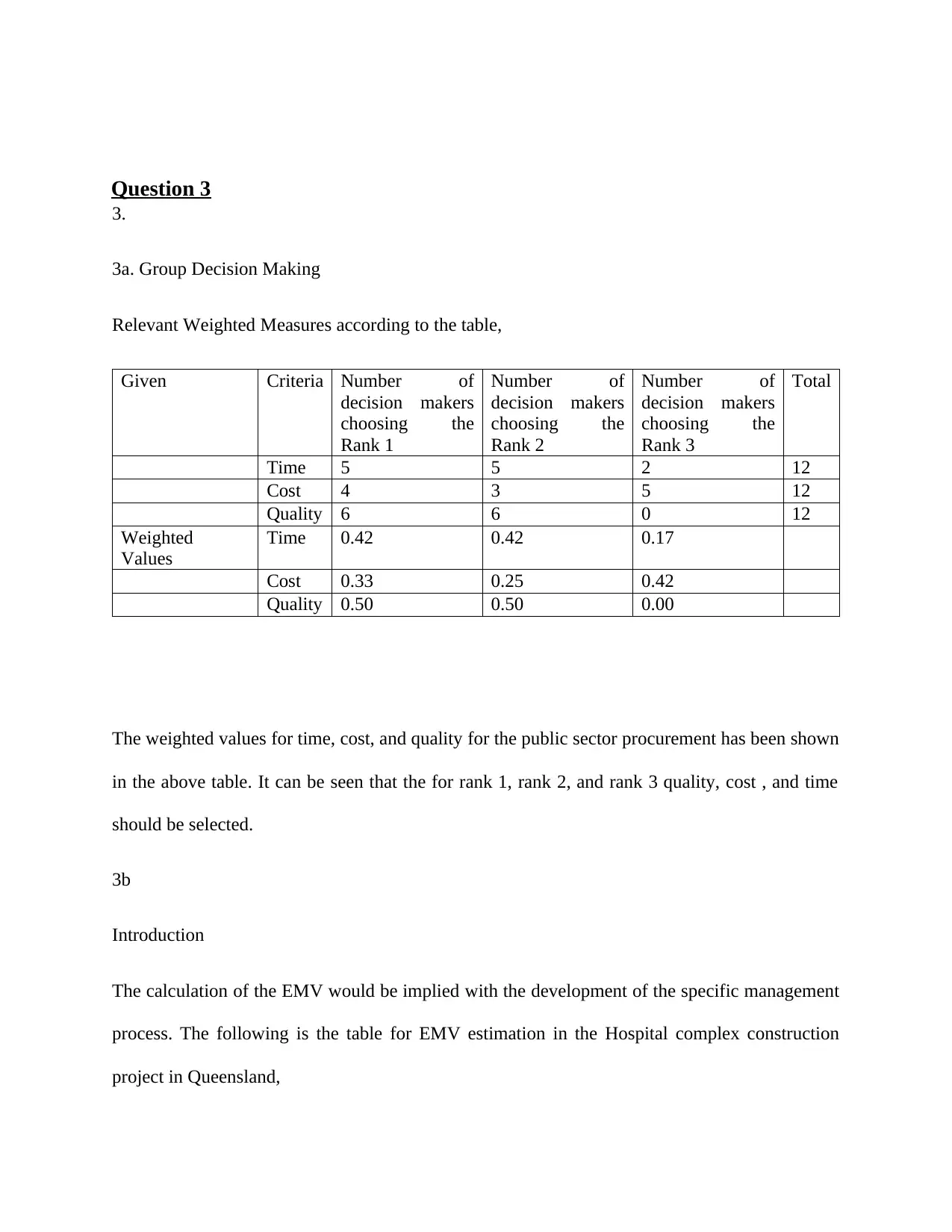
Question 3
3.
3a. Group Decision Making
Relevant Weighted Measures according to the table,
Given Criteria Number of
decision makers
choosing the
Rank 1
Number of
decision makers
choosing the
Rank 2
Number of
decision makers
choosing the
Rank 3
Total
Time 5 5 2 12
Cost 4 3 5 12
Quality 6 6 0 12
Weighted
Values
Time 0.42 0.42 0.17
Cost 0.33 0.25 0.42
Quality 0.50 0.50 0.00
The weighted values for time, cost, and quality for the public sector procurement has been shown
in the above table. It can be seen that the for rank 1, rank 2, and rank 3 quality, cost , and time
should be selected.
3b
Introduction
The calculation of the EMV would be implied with the development of the specific management
process. The following is the table for EMV estimation in the Hospital complex construction
project in Queensland,
3.
3a. Group Decision Making
Relevant Weighted Measures according to the table,
Given Criteria Number of
decision makers
choosing the
Rank 1
Number of
decision makers
choosing the
Rank 2
Number of
decision makers
choosing the
Rank 3
Total
Time 5 5 2 12
Cost 4 3 5 12
Quality 6 6 0 12
Weighted
Values
Time 0.42 0.42 0.17
Cost 0.33 0.25 0.42
Quality 0.50 0.50 0.00
The weighted values for time, cost, and quality for the public sector procurement has been shown
in the above table. It can be seen that the for rank 1, rank 2, and rank 3 quality, cost , and time
should be selected.
3b
Introduction
The calculation of the EMV would be implied with the development of the specific management
process. The following is the table for EMV estimation in the Hospital complex construction
project in Queensland,
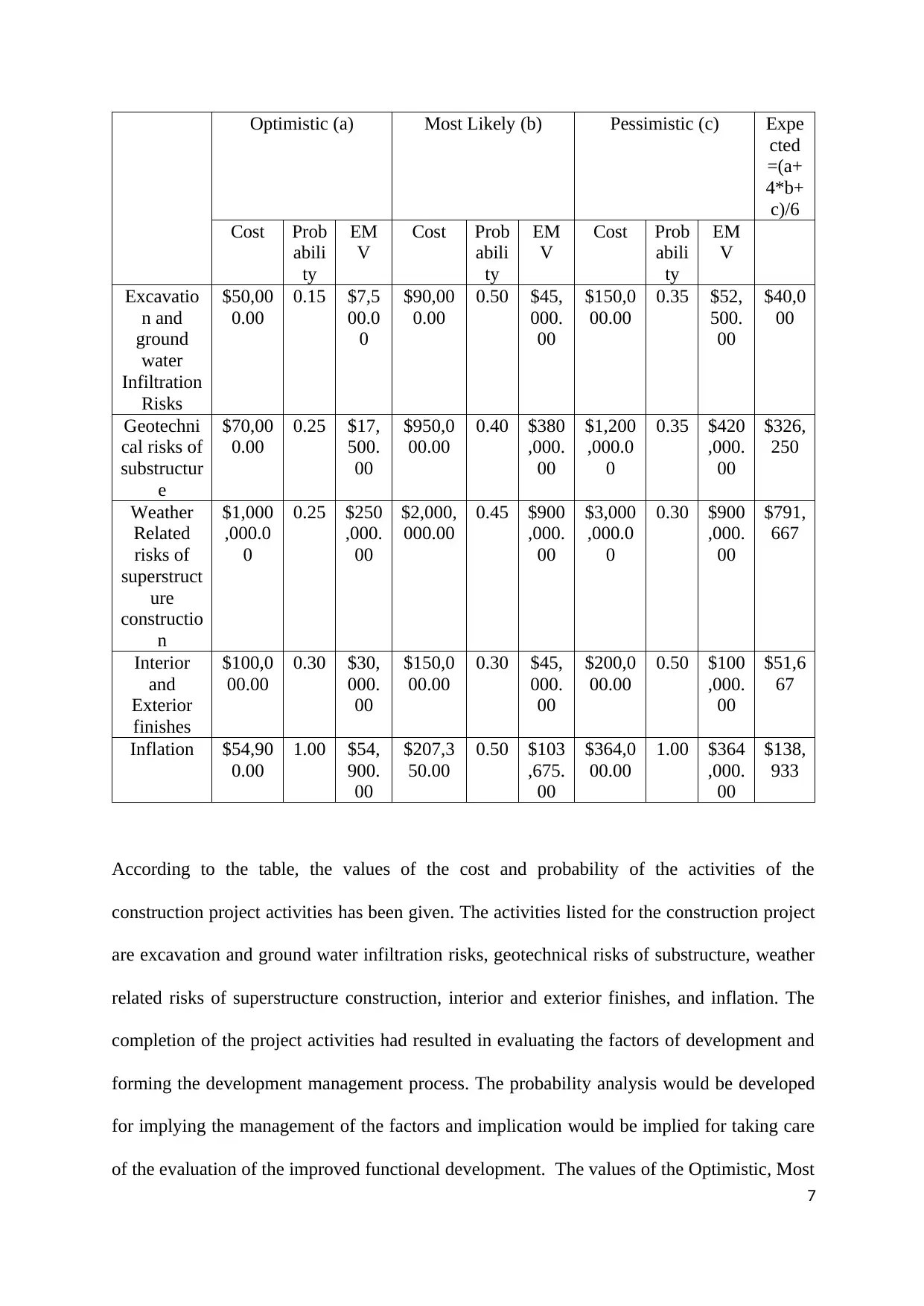
Optimistic (a) Most Likely (b) Pessimistic (c) Expe
cted
=(a+
4*b+
c)/6
Cost Prob
abili
ty
EM
V
Cost Prob
abili
ty
EM
V
Cost Prob
abili
ty
EM
V
Excavatio
n and
ground
water
Infiltration
Risks
$50,00
0.00
0.15 $7,5
00.0
0
$90,00
0.00
0.50 $45,
000.
00
$150,0
00.00
0.35 $52,
500.
00
$40,0
00
Geotechni
cal risks of
substructur
e
$70,00
0.00
0.25 $17,
500.
00
$950,0
00.00
0.40 $380
,000.
00
$1,200
,000.0
0
0.35 $420
,000.
00
$326,
250
Weather
Related
risks of
superstruct
ure
constructio
n
$1,000
,000.0
0
0.25 $250
,000.
00
$2,000,
000.00
0.45 $900
,000.
00
$3,000
,000.0
0
0.30 $900
,000.
00
$791,
667
Interior
and
Exterior
finishes
$100,0
00.00
0.30 $30,
000.
00
$150,0
00.00
0.30 $45,
000.
00
$200,0
00.00
0.50 $100
,000.
00
$51,6
67
Inflation $54,90
0.00
1.00 $54,
900.
00
$207,3
50.00
0.50 $103
,675.
00
$364,0
00.00
1.00 $364
,000.
00
$138,
933
According to the table, the values of the cost and probability of the activities of the
construction project activities has been given. The activities listed for the construction project
are excavation and ground water infiltration risks, geotechnical risks of substructure, weather
related risks of superstructure construction, interior and exterior finishes, and inflation. The
completion of the project activities had resulted in evaluating the factors of development and
forming the development management process. The probability analysis would be developed
for implying the management of the factors and implication would be implied for taking care
of the evaluation of the improved functional development. The values of the Optimistic, Most
7
cted
=(a+
4*b+
c)/6
Cost Prob
abili
ty
EM
V
Cost Prob
abili
ty
EM
V
Cost Prob
abili
ty
EM
V
Excavatio
n and
ground
water
Infiltration
Risks
$50,00
0.00
0.15 $7,5
00.0
0
$90,00
0.00
0.50 $45,
000.
00
$150,0
00.00
0.35 $52,
500.
00
$40,0
00
Geotechni
cal risks of
substructur
e
$70,00
0.00
0.25 $17,
500.
00
$950,0
00.00
0.40 $380
,000.
00
$1,200
,000.0
0
0.35 $420
,000.
00
$326,
250
Weather
Related
risks of
superstruct
ure
constructio
n
$1,000
,000.0
0
0.25 $250
,000.
00
$2,000,
000.00
0.45 $900
,000.
00
$3,000
,000.0
0
0.30 $900
,000.
00
$791,
667
Interior
and
Exterior
finishes
$100,0
00.00
0.30 $30,
000.
00
$150,0
00.00
0.30 $45,
000.
00
$200,0
00.00
0.50 $100
,000.
00
$51,6
67
Inflation $54,90
0.00
1.00 $54,
900.
00
$207,3
50.00
0.50 $103
,675.
00
$364,0
00.00
1.00 $364
,000.
00
$138,
933
According to the table, the values of the cost and probability of the activities of the
construction project activities has been given. The activities listed for the construction project
are excavation and ground water infiltration risks, geotechnical risks of substructure, weather
related risks of superstructure construction, interior and exterior finishes, and inflation. The
completion of the project activities had resulted in evaluating the factors of development and
forming the development management process. The probability analysis would be developed
for implying the management of the factors and implication would be implied for taking care
of the evaluation of the improved functional development. The values of the Optimistic, Most
7
Paraphrase This Document
Need a fresh take? Get an instant paraphrase of this document with our AI Paraphraser
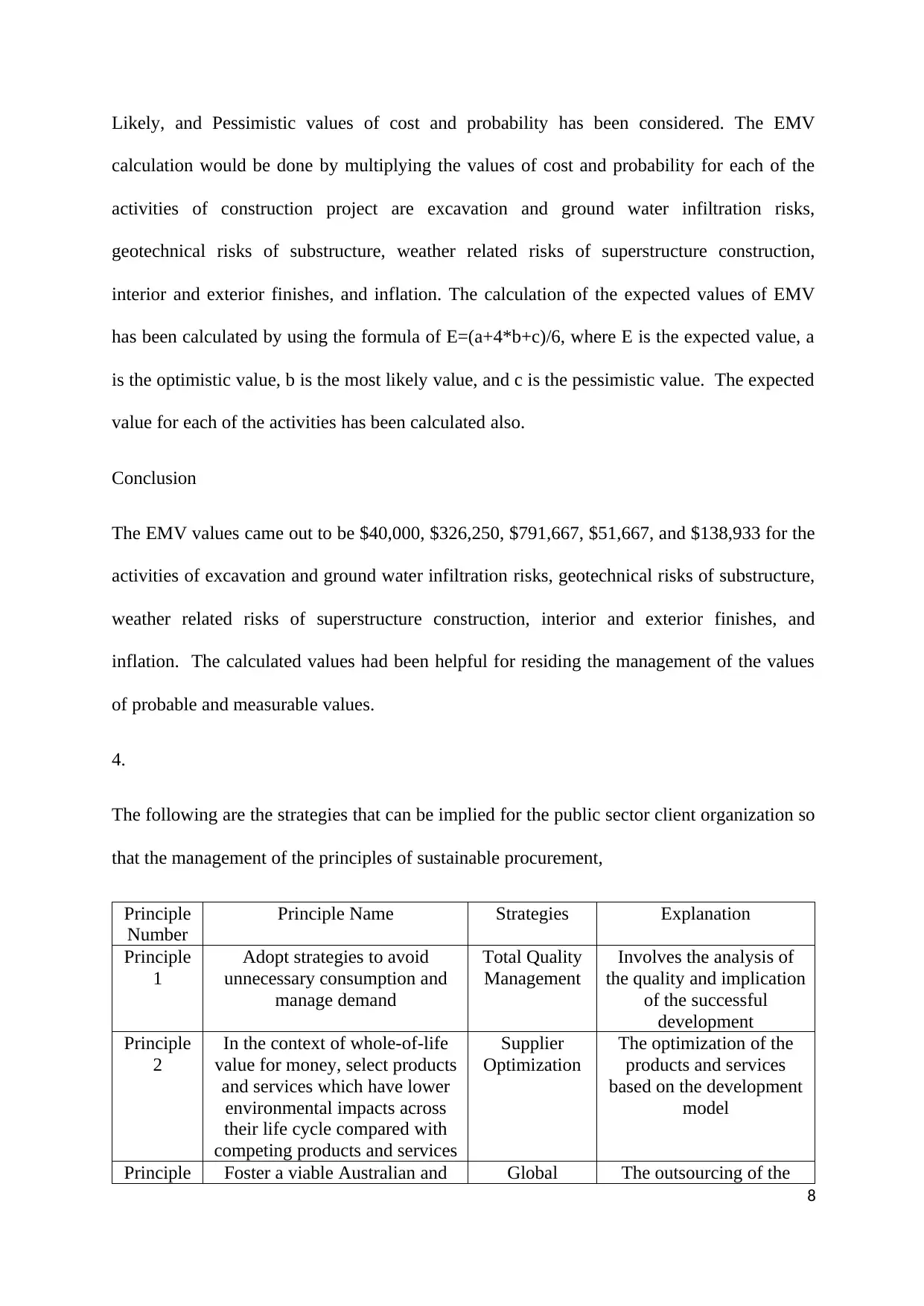
Likely, and Pessimistic values of cost and probability has been considered. The EMV
calculation would be done by multiplying the values of cost and probability for each of the
activities of construction project are excavation and ground water infiltration risks,
geotechnical risks of substructure, weather related risks of superstructure construction,
interior and exterior finishes, and inflation. The calculation of the expected values of EMV
has been calculated by using the formula of E=(a+4*b+c)/6, where E is the expected value, a
is the optimistic value, b is the most likely value, and c is the pessimistic value. The expected
value for each of the activities has been calculated also.
Conclusion
The EMV values came out to be $40,000, $326,250, $791,667, $51,667, and $138,933 for the
activities of excavation and ground water infiltration risks, geotechnical risks of substructure,
weather related risks of superstructure construction, interior and exterior finishes, and
inflation. The calculated values had been helpful for residing the management of the values
of probable and measurable values.
4.
The following are the strategies that can be implied for the public sector client organization so
that the management of the principles of sustainable procurement,
Principle
Number
Principle Name Strategies Explanation
Principle
1
Adopt strategies to avoid
unnecessary consumption and
manage demand
Total Quality
Management
Involves the analysis of
the quality and implication
of the successful
development
Principle
2
In the context of whole-of-life
value for money, select products
and services which have lower
environmental impacts across
their life cycle compared with
competing products and services
Supplier
Optimization
The optimization of the
products and services
based on the development
model
Principle Foster a viable Australian and Global The outsourcing of the
8
calculation would be done by multiplying the values of cost and probability for each of the
activities of construction project are excavation and ground water infiltration risks,
geotechnical risks of substructure, weather related risks of superstructure construction,
interior and exterior finishes, and inflation. The calculation of the expected values of EMV
has been calculated by using the formula of E=(a+4*b+c)/6, where E is the expected value, a
is the optimistic value, b is the most likely value, and c is the pessimistic value. The expected
value for each of the activities has been calculated also.
Conclusion
The EMV values came out to be $40,000, $326,250, $791,667, $51,667, and $138,933 for the
activities of excavation and ground water infiltration risks, geotechnical risks of substructure,
weather related risks of superstructure construction, interior and exterior finishes, and
inflation. The calculated values had been helpful for residing the management of the values
of probable and measurable values.
4.
The following are the strategies that can be implied for the public sector client organization so
that the management of the principles of sustainable procurement,
Principle
Number
Principle Name Strategies Explanation
Principle
1
Adopt strategies to avoid
unnecessary consumption and
manage demand
Total Quality
Management
Involves the analysis of
the quality and implication
of the successful
development
Principle
2
In the context of whole-of-life
value for money, select products
and services which have lower
environmental impacts across
their life cycle compared with
competing products and services
Supplier
Optimization
The optimization of the
products and services
based on the development
model
Principle Foster a viable Australian and Global The outsourcing of the
8
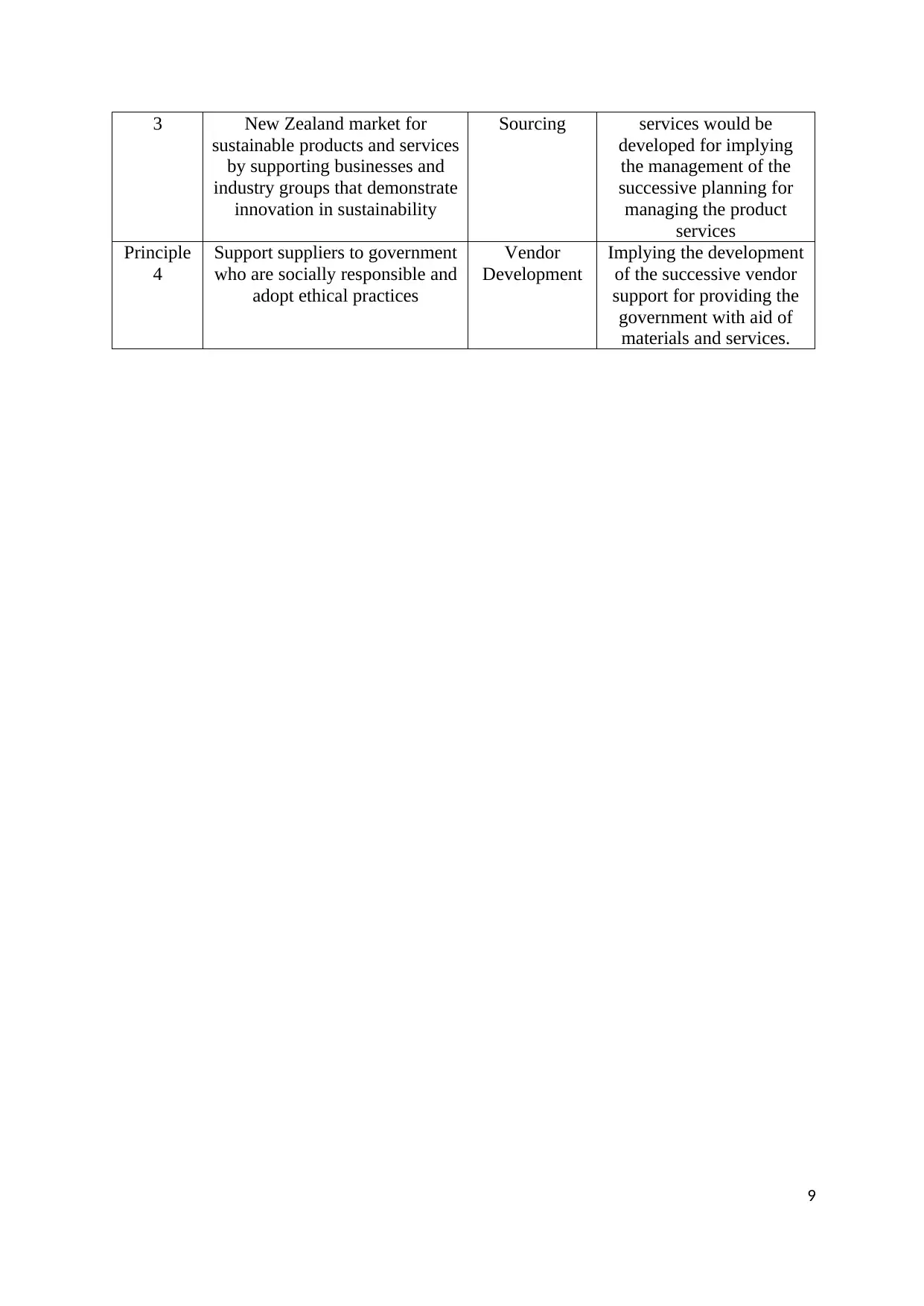
3 New Zealand market for
sustainable products and services
by supporting businesses and
industry groups that demonstrate
innovation in sustainability
Sourcing services would be
developed for implying
the management of the
successive planning for
managing the product
services
Principle
4
Support suppliers to government
who are socially responsible and
adopt ethical practices
Vendor
Development
Implying the development
of the successive vendor
support for providing the
government with aid of
materials and services.
9
sustainable products and services
by supporting businesses and
industry groups that demonstrate
innovation in sustainability
Sourcing services would be
developed for implying
the management of the
successive planning for
managing the product
services
Principle
4
Support suppliers to government
who are socially responsible and
adopt ethical practices
Vendor
Development
Implying the development
of the successive vendor
support for providing the
government with aid of
materials and services.
9
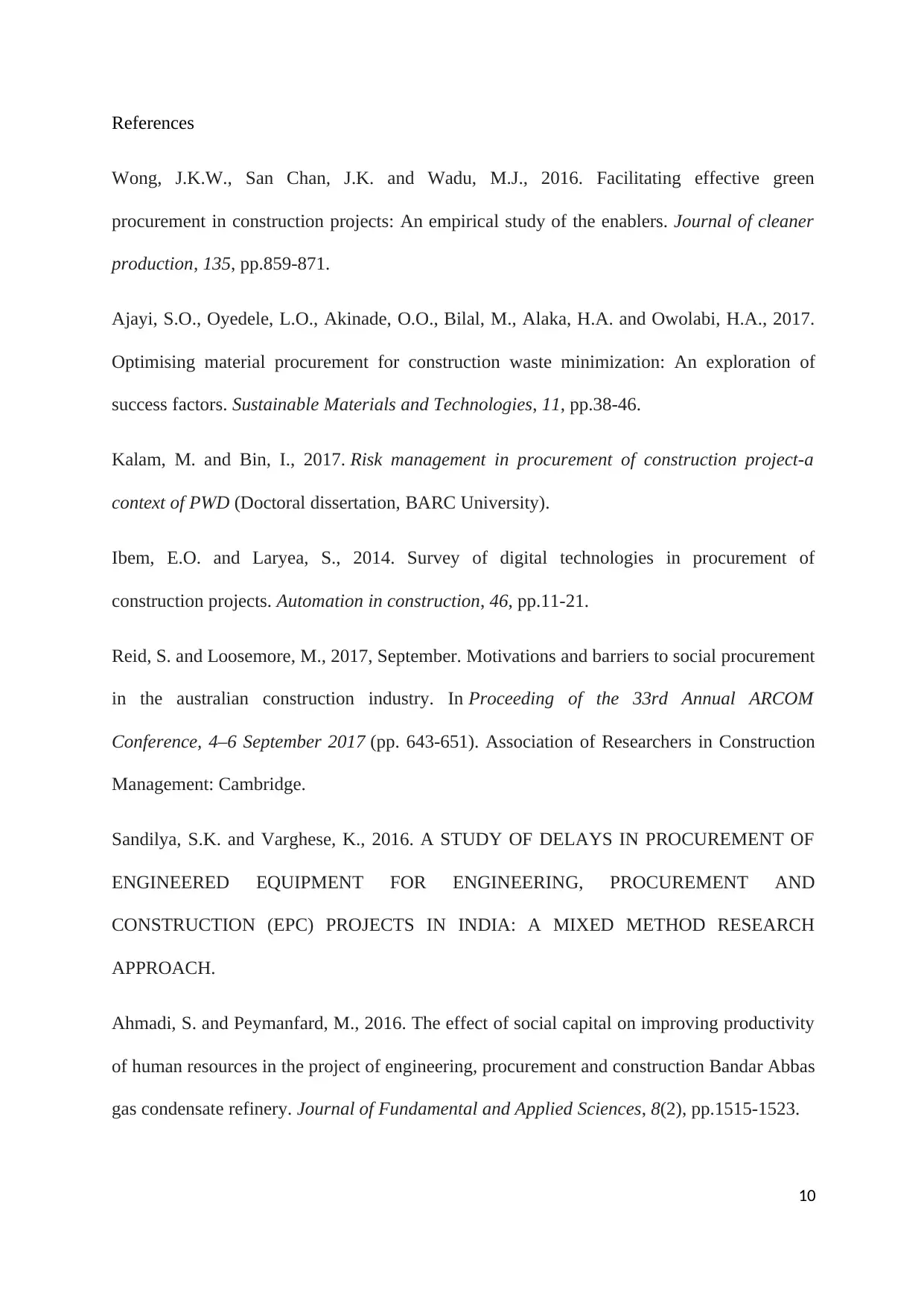
References
Wong, J.K.W., San Chan, J.K. and Wadu, M.J., 2016. Facilitating effective green
procurement in construction projects: An empirical study of the enablers. Journal of cleaner
production, 135, pp.859-871.
Ajayi, S.O., Oyedele, L.O., Akinade, O.O., Bilal, M., Alaka, H.A. and Owolabi, H.A., 2017.
Optimising material procurement for construction waste minimization: An exploration of
success factors. Sustainable Materials and Technologies, 11, pp.38-46.
Kalam, M. and Bin, I., 2017. Risk management in procurement of construction project-a
context of PWD (Doctoral dissertation, BARC University).
Ibem, E.O. and Laryea, S., 2014. Survey of digital technologies in procurement of
construction projects. Automation in construction, 46, pp.11-21.
Reid, S. and Loosemore, M., 2017, September. Motivations and barriers to social procurement
in the australian construction industry. In Proceeding of the 33rd Annual ARCOM
Conference, 4–6 September 2017 (pp. 643-651). Association of Researchers in Construction
Management: Cambridge.
Sandilya, S.K. and Varghese, K., 2016. A STUDY OF DELAYS IN PROCUREMENT OF
ENGINEERED EQUIPMENT FOR ENGINEERING, PROCUREMENT AND
CONSTRUCTION (EPC) PROJECTS IN INDIA: A MIXED METHOD RESEARCH
APPROACH.
Ahmadi, S. and Peymanfard, M., 2016. The effect of social capital on improving productivity
of human resources in the project of engineering, procurement and construction Bandar Abbas
gas condensate refinery. Journal of Fundamental and Applied Sciences, 8(2), pp.1515-1523.
10
Wong, J.K.W., San Chan, J.K. and Wadu, M.J., 2016. Facilitating effective green
procurement in construction projects: An empirical study of the enablers. Journal of cleaner
production, 135, pp.859-871.
Ajayi, S.O., Oyedele, L.O., Akinade, O.O., Bilal, M., Alaka, H.A. and Owolabi, H.A., 2017.
Optimising material procurement for construction waste minimization: An exploration of
success factors. Sustainable Materials and Technologies, 11, pp.38-46.
Kalam, M. and Bin, I., 2017. Risk management in procurement of construction project-a
context of PWD (Doctoral dissertation, BARC University).
Ibem, E.O. and Laryea, S., 2014. Survey of digital technologies in procurement of
construction projects. Automation in construction, 46, pp.11-21.
Reid, S. and Loosemore, M., 2017, September. Motivations and barriers to social procurement
in the australian construction industry. In Proceeding of the 33rd Annual ARCOM
Conference, 4–6 September 2017 (pp. 643-651). Association of Researchers in Construction
Management: Cambridge.
Sandilya, S.K. and Varghese, K., 2016. A STUDY OF DELAYS IN PROCUREMENT OF
ENGINEERED EQUIPMENT FOR ENGINEERING, PROCUREMENT AND
CONSTRUCTION (EPC) PROJECTS IN INDIA: A MIXED METHOD RESEARCH
APPROACH.
Ahmadi, S. and Peymanfard, M., 2016. The effect of social capital on improving productivity
of human resources in the project of engineering, procurement and construction Bandar Abbas
gas condensate refinery. Journal of Fundamental and Applied Sciences, 8(2), pp.1515-1523.
10
Secure Best Marks with AI Grader
Need help grading? Try our AI Grader for instant feedback on your assignments.
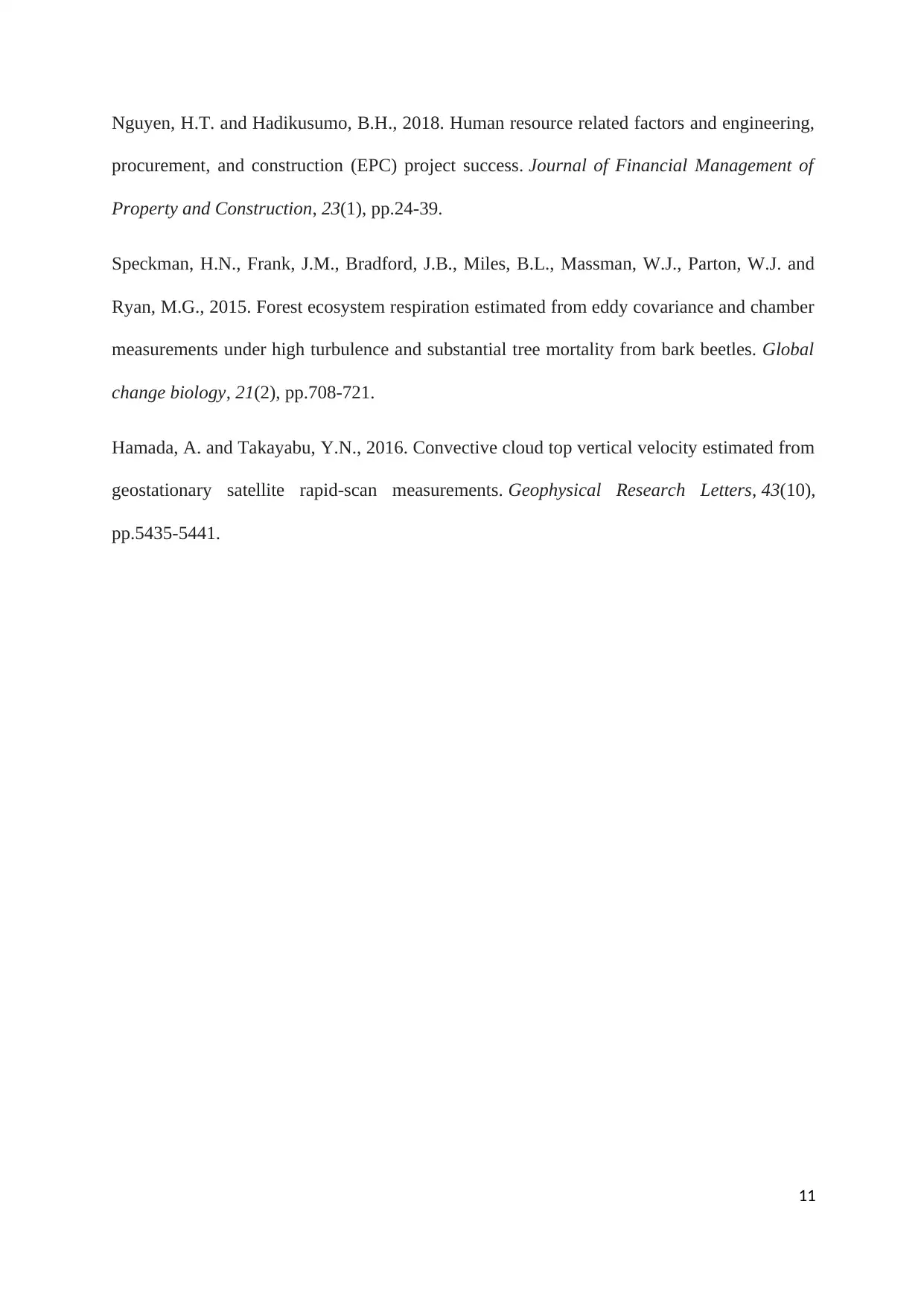
Nguyen, H.T. and Hadikusumo, B.H., 2018. Human resource related factors and engineering,
procurement, and construction (EPC) project success. Journal of Financial Management of
Property and Construction, 23(1), pp.24-39.
Speckman, H.N., Frank, J.M., Bradford, J.B., Miles, B.L., Massman, W.J., Parton, W.J. and
Ryan, M.G., 2015. Forest ecosystem respiration estimated from eddy covariance and chamber
measurements under high turbulence and substantial tree mortality from bark beetles. Global
change biology, 21(2), pp.708-721.
Hamada, A. and Takayabu, Y.N., 2016. Convective cloud top vertical velocity estimated from
geostationary satellite rapid‐scan measurements. Geophysical Research Letters, 43(10),
pp.5435-5441.
11
procurement, and construction (EPC) project success. Journal of Financial Management of
Property and Construction, 23(1), pp.24-39.
Speckman, H.N., Frank, J.M., Bradford, J.B., Miles, B.L., Massman, W.J., Parton, W.J. and
Ryan, M.G., 2015. Forest ecosystem respiration estimated from eddy covariance and chamber
measurements under high turbulence and substantial tree mortality from bark beetles. Global
change biology, 21(2), pp.708-721.
Hamada, A. and Takayabu, Y.N., 2016. Convective cloud top vertical velocity estimated from
geostationary satellite rapid‐scan measurements. Geophysical Research Letters, 43(10),
pp.5435-5441.
11
1 out of 11
Your All-in-One AI-Powered Toolkit for Academic Success.
+13062052269
info@desklib.com
Available 24*7 on WhatsApp / Email
![[object Object]](/_next/static/media/star-bottom.7253800d.svg)
Unlock your academic potential
© 2024 | Zucol Services PVT LTD | All rights reserved.